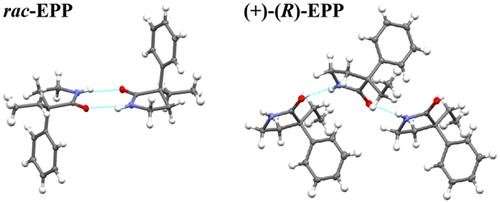Scientists developing a pharmaceutical that stops convulsions

Scientists from RUDN University took an active part in the development of a chemical compound to stop convulsions during epileptic seizures. The results of the study were published in Chirality.
Epilepsy is a chronic neuralgic disease that causes convulsive seizures in humans and other animals. The pathogenesis of this disease is paroxysmal discharges in the nerve cells of the brain that cause convulsions. Anticonvulsants help to stop the epileptic fit. The drug itself is a powder that is dissolved in water and injected into a person experiencing such a seizure.
In order to obtain a new anticonvulsant, scientists have developed a compound with a chirality—an asymmetric carbon atom with a configuration incompatibility of the left and right forms of the molecule—this is analogous to difference between left and right hands. Thus, the nearest environment of the chiral center is a tetrahedron—a regular trigonal pyramid in the middle of which there is a chiral carbon atom and at its vertices are substituents—atoms or groups of atoms replacing hydrogen atoms in hydrocarbon fragments. The chirality of this construction is these four substituents are differently arranged in space relative to each other. In other words, if we isolate individual 3-D models of these tetrahedra from the structure of the molecule and try to combine them, they will not coincide.
"One of the most important areas of our scientific research is chemicals that have potential biological activity. In this case, the studied compounds have a specific activity—they are anticonvulsants. This is a common property of compounds of this class, but in order for compounds to show these properties more efficiently, they must be chirally (optically) pure—that is, the asymmetric centers of all molecules in the total substance mass must be of the same configuration. The published paper is devoted to the method of separation of racemic mixtures that contain molecules with various absolute (R or S) configurations of chiral carbon atoms," said chemist Victor Khrustalev of RUDN University.
Scientists synthesized and studied the structure of 3-ethyl-2-phenylpyrrolidin-2-1 (EPP) showing anticonvulsant activity. The compound can exist in three forms: as two chirally pure R / S stereoisomers and a racemate—a mixture of molecules with different R and S configurations of the asymmetric center.
All three forms show biological activity to varying degrees. The authors found that the compound effectively helps to stop convulsions only when it is chirally pure—that is, it contains molecules of only one configuration, either R or S. When the compound is produced under normal conditions, a racemate is always formed, which makes it difficult to use in medical practice.
In the course of the work, the scientists synthesized the compound with the desired chemical formula in the form of a racemate, which was confirmed by the methods of NMR and IR spectroscopy. Then, with the use of high-resolution liquid chromatography, the authors divided the racemic mixture into optically pure stereoisomers. Thus, the researchers separated the necessary forms of a given chemical compound, which can later serve as a basis for a new drug. The scientists confirmed that there are molecules of only one configuration in the isolated forms after examining them by means of X-ray diffraction analysis.
More information: Arcadius V. Krivoshein et al, Racemic and enantiopure forms of 3-ethyl-3-phenylpyrrolidin-2-one adopt very different crystal structures, Chirality (2017). DOI: 10.1002/chir.22735
Provided by RUDN University





















